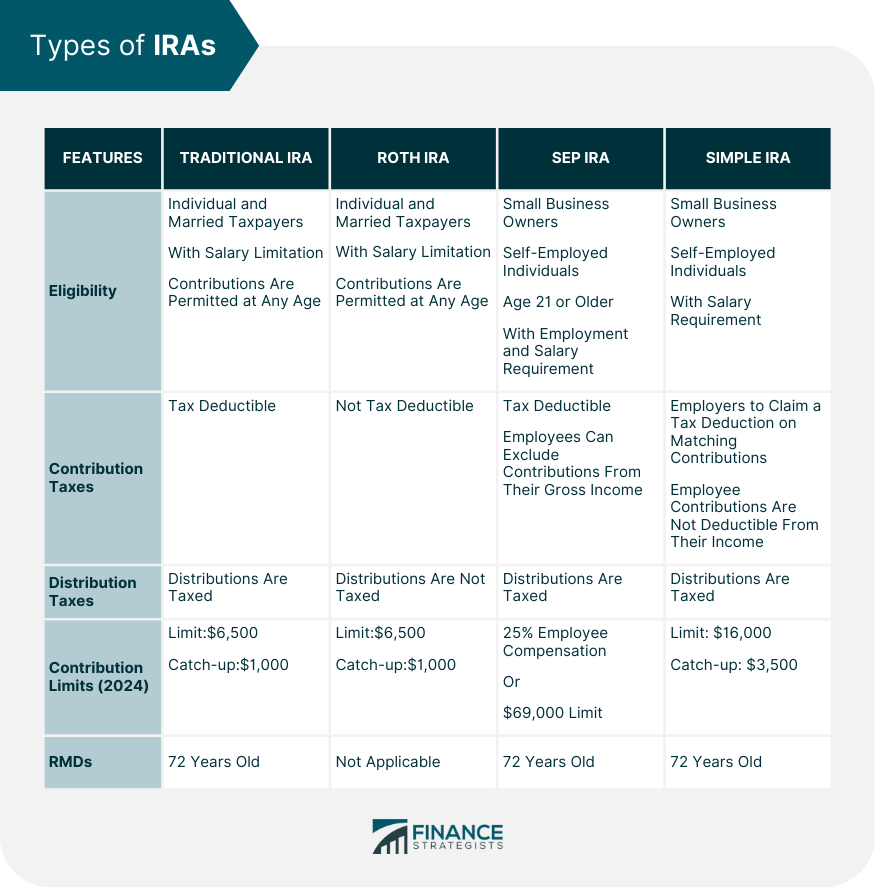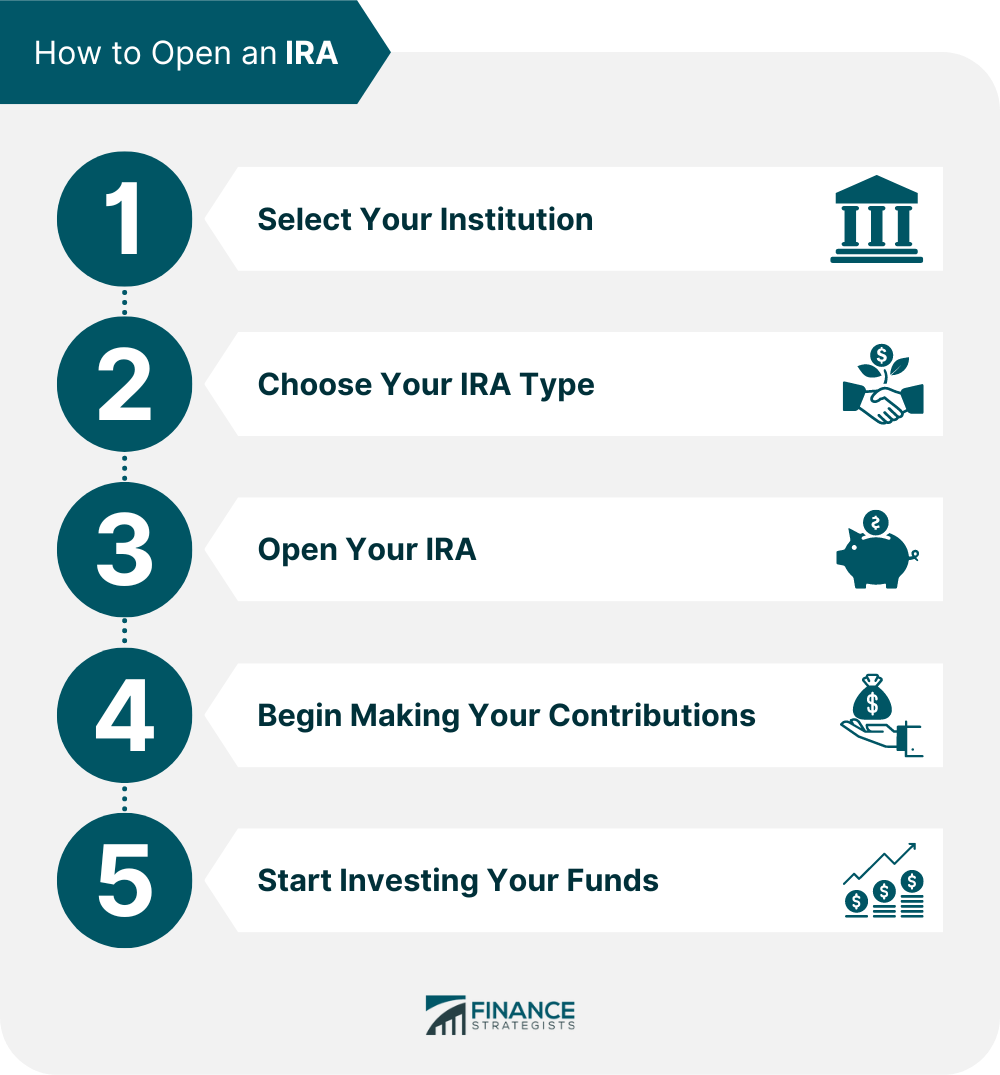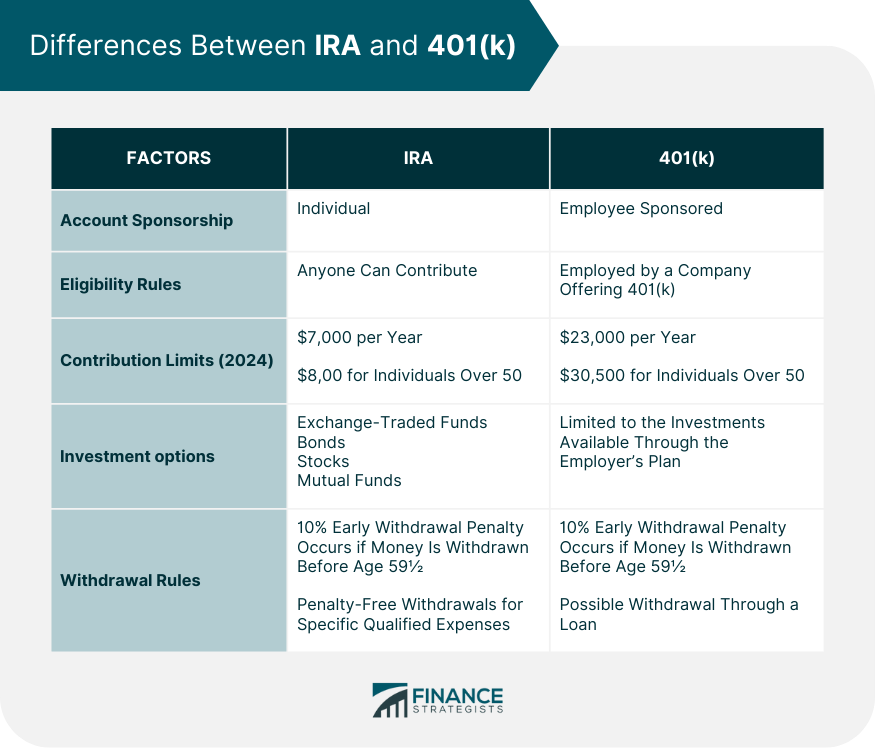Individual retirement accounts (IRAs) are tax-advantaged investment accounts and are one of the most efficient methods of saving and investing for the future. An IRA allows contributions as pre-tax dollars. Contributions are exempt from federal income taxes. Depending on the type of account, they allow your money to grow tax-deferred or tax-free until you withdraw them in retirement. This retirement savings account has been around since 1974 when Congress passed the Employee Retirement Income Security Act (ERISA) intended for retirement savings to those without access to an employer-sponsored plan. Initially, IRA eligibility was limited. However, the 1981 Economic Recovery Tax Act made revisions to allow taxpayers under 70 years old to contribute to IRAs. Over the years, changes have been implemented to the IRA to expand contribution limits and make saving easier. Anyone with wages can open an IRA and put money into it, even if they already have a 401(k) through their employment. The amount you contribute to your IRA is tax-deductible, reducing your taxable income. The money you save grows over time and is not taxed until you withdraw it in retirement. However, early withdrawals may incur an additional 10% penalty. There are exceptions, though, like withdrawing for a first-time home purchase or covering medical expenses. The money you contribute to your IRA can be invested in various assets, such as stocks, bonds, mutual funds, and exchange-traded funds (ETFs). An IRA can be opened at most banks, credit unions, internet brokers, and financial firms. There are main types to choose from, each with its features and benefits. The table at the end of this section summarizes relevant information for each type, such as eligibility, contribution limits, catch-up contributions, required minimum distribution (RMD) and investment options. This is the most popular of the individual retirement accounts according to Investment Company Institute (ICI) data. Contributions to a traditional IRA may be entirely or partially deductible, depending on your filing status and income. Generally, funds in your traditional IRA, including earnings and profits, are taxed once you receive a distribution from your IRA. The maximum annual contribution for 2024 is $7,000. The catch-up payment for people over 50 remains at $1,000. Contributions to traditional IRA are allowed at any age and there are no income limits. Your first RMD must be taken by April 1st of the year after your 73rd birthday. Following RMDs must be taken by December 31st of each year. If you do not take your RMD, you must pay a penalty of 25% of the RMD amount. The same rules apply for SEP and SIMPLE IRA. Anyone with earned income, including a 401(k) plan through their company, can open and contribute to an IRA. However, not everyone can deduct contributions from a regular IRA. Suppose you or your spouse have a workplace retirement plan like a 401(k). In that case, your modified adjusted gross income (MAGI) influences whether and how much of your traditional IRA contributions can be deducted. A traditional IRA contribution can be deducted in full by a single filer who does not have an employer-sponsored retirement plan. However, if your employer has a retirement plan, the following income limits apply: Different limits apply if you are married filing jointly or married filing separately. Traditional IRAs are intended for those at a higher tax rate today than expected when they retire, and employees who are not qualified to contribute to a workplace-sponsored retirement plan. A Roth IRA is subject to the same rules as a standard IRA, with some exceptions. Contributions to a Roth IRA are not deductible, and qualified distributions are tax-free if you meet the requirements. While there are no current-year tax advantages, your contributions and profits can grow tax-free. And you can withdraw them tax-free and penalty-free after age 59 1/2 and if the account is five years active. Individuals under 50 who are eligible can contribute up to $7,000 in 2024. Within a given tax year, eligible individuals aged 50 and up can make an additional $1,000 catch-up contribution. Contributions to Roth IRA are allowed after you reach the age of 73 and for as long as you live and your income falls within the permissible income limits. Roth IRAs do not require withdrawals until the owner dies; nevertheless, Roth IRA beneficiaries are subject to the RMD restrictions. Individuals at any age with earned income together with their spouse if filing jointly must observe modified adjusted gross income limits. Your income determines the maximum amount you can contribute to a Roth IRA. If your MAGI is less than $138,000 (single) or $218,000 (married), you will get full contribution. If your MAGI is between $138,000 and $153,000 (single) or $218,000 and $228,000 (married), you may be eligible for a partial contribution. No contribution if MAGI exceeds $153,000 (single) or $228,000 (married). A Roth IRA may be more advantageous than a traditional IRA if you anticipate being in a higher tax bracket when you retire than where you are now. A simplified employee pension plan (SEP), often known as SEP-IRA, is a type of IRA plan that gives employers greater flexibility than a traditional IRA account. SEP is an excellent choice for self-employed or small business owners. Employer contributions to a SEP-IRA are tax deductible, while withdrawals are taxed as income. A SEP-IRA does not have mandatory annual contributions like a traditional IRA but instead allows the employer to reduce contributions when business is slow. Employers are the only ones who can set up and contribute to a SEP-IRA and must do so at the same rate for all employees. The yearly contribution limits for a SEP-IRA are significantly larger than those for conventional IRAs. A qualified employee for a SEP plan must reach the age of 21, work for the company for at least three of the last five years, and receive at least $600 in salary from the employer during the year. SEP is an excellent choice for self-employed or small business owners. The Savings Incentive Match Plan for Employees (SIMPLE) IRA is ideal for self-employed individuals and small business owners with 100 or fewer employees. This type of IRA offers flexibility when it comes to contributions and withdrawals. All contributions are tax-deductible, which may result in a lower tax rate for the firm or employee. In 2024, the contribution limit is $16,000. The catch-up contributions for people 50 years and older is $3,500. SIMPLE IRA complies with the same withdrawal tax regulations as a traditional IRA. A qualified employee (including the self-employed) for a SIMPLE IRA must earn at least $5,000 in salary in the two years before the current calendar year and expect to receive at least $5,000 in the current year. Below are some specialized types of IRA that may be suitable for certain individuals: A Rollover IRA is a traditional IRA that allows you to move money from one pre-retirement payment, such as a 401(k) into an IRA without paying taxes or penalties. The funds remain tax-deferred until withdrawals are made in retirement. A retirement account is suitable for those needing more diversification and asset control. A self-directed IRA allows you to invest in certain alternative investments such as real estate, private placements, promissory notes, and precious metals. A spousal IRA is a traditional or Roth IRA that allows married couples to save for retirement. It will enable the spouse who earns less or is not working to contribute to the same limits as their higher-earning partner. An inherited IRA is a type of IRA that allows the beneficiary of an existing traditional, Roth, or SEP IRA to continue the tax-deferred growth of the account. The rules for inherited IRAs vary depending on whether you are a spouse or a non-spouse beneficiary. In principle, visit a provider's website, select the type of IRA you wish to start, provide the required personal information and build up your savings. Many financial institutions offer IRAs. These are generally banks, brokerages, mutual fund companies, and robo-advisors. You will want to shop around and determine which is best for you based on fees, customer service, investment options, and other factors based on your needs. Decide which type of IRA account is right for you. Consider eligibility requirements, tax benefits, investment options, fees, and services offered by each type of IRA. Account owners can choose from a traditional IRA, Roth IRA, SEP IRA, SIMPLE IRA, or other specialized types of IRAs. Once you have selected your institution, you must open an account with them. You can do this online or in person. You must provide personal information like your Social Security number, birth date, and address when you open the account. Details about your beneficiaries, banking information, contribution method, and investment choices will also be required. Fees apply to open and maintain the account. You can start contributing to your IRA as soon as the account opens. Most institutions allow you to make contributions by check, direct deposit, or payroll deduction. Determine how much you will contribute each month, and make sure you know the annual contribution limits to make the most of your IRA. Once contributions have been made, you can start investing in stocks, bonds, mutual funds, ETFs, and other financial instruments. Most institutions limit the number of investments available in IRAs, so ensure you understand what kinds of investments are allowed by each institution before investing. Before investing, understand your financial goals, risk tolerance, and investment preferences. Consider speaking with a professional financial advisor if you are still determining your options. IRAs and 401(k)s are two of the most popular retirement savings options for individuals. Both offer tax advantages and are effective tools for long-term investing. Still, each has unique features that suit different savers best. 401(k)s are only available through an employer. If you are self-employed or do not have access to a 401(k) from your job, an IRA may be the better option. With a 401(k), you can make pre-tax contributions up to the annual contribution limit, and all earnings grow tax-deferred until withdrawal. You will only pay taxes on your contributions once you withdraw them in retirement. Depending on your income, IRAs may offer tax-deferred growth, and the contributions are taxed when withdrawn. There is no pre-tax benefit when contributing to an IRA. Still, you can deduct your IRA contributions from your taxes if you qualify. IRA account owners must fund their accounts to contribute and have a maximum contribution limit of $7,000 per year or $8,000 for individuals age 50 or older in 2024. 401(k) contributions are taken automatically from paychecks, and employers offer to match a percentage of employee contributions up to the annual contribution limit. Standard limits for 401(k) contributions in 2024 are $23,000 and $30,500 for individuals age 50 and older because of their additional catch-up contributions. Generally, a 10% early withdrawal penalty occurs if money is withdrawn from a 401(k) or an IRA before age 59½. However, taking a loan out of a 401(k) is possible but not with an IRA. IRA allows penalty-free withdrawals for specific qualified expenses, such as a first-time home purchase, higher education, disability, or medical premiums payment. The number and selection for investments are typically larger in an IRA. It can hold various investments, from stocks and bonds to mutual and exchange-traded funds. 401(k) options are generally limited to the investments available through the employer’s plan. IRA benefits include accessibility, flexibility, and control over contributions, investments, and situation-considerate withdrawal rules. On the other hand, 401(k)s offer potential employer matching contributions and may have lower fees, and they have high contribution limits to help you save more. The main drawbacks of IRAs are their low contribution limits and owners receive no investment advice. 401(k)s have high account fees and limited investment options. An IRA is a tax-advantaged investment account in which you can save for retirement. You can choose from different types of IRAs, the traditional IRA and the Roth IRA. The main difference is how taxes are handled on contributions and withdrawals. Other types include SEP IRAs and SIMPLE IRAs. Additionally, more specific types of IRAs may best serve individuals' needs in particular circumstances. These types include rollover IRAs, self-directed IRAs, spousal IRAs, and inherited IRAs. To open an IRA, you must choose an institution, select an IRA type, make an account with your chosen firm, begin your contributions, and start investing. Make sure to do your research to find the best IRA account and make sure to consider fees, taxes, and other restrictions. The critical difference between an IRA and a 401(k) is that 401(k)s are employer-sponsored plans and IRAs are individual accounts. There are also differences in the contribution limits and the available investment options.What Is an IRA?
How IRAs Work
Types of IRAs
Traditional IRA
Tax Implications
Contribution Rules
RMD Rules
Eligibility
Intended For
Roth IRA
Tax Implications
Contribution Rules
RMD Rules
Eligibility
Intended For
SEP IRA
Tax Implications
Contribution Rules
Eligibility
Intended For
SIMPLE IRA
Tax Implications
Contribution Rules
Eligibility

Other Types of IRAs
Rollover IRAs
Self-Directed IRAs
Spousal IRAs
Inherited IRAs
How to Open an IRA
Step 1: Select Your Institution
Step 2: Choose Your IRA Type
Step 3: Open Your IRA
Step 4: Begin Making Your Contributions
Step 5: Start Investing Your Funds

IRAs vs 401(k)s
Eligibility
Tax Advantages
Contributions
Withdrawal Rules
Investment Options
Benefits
Drawbacks

Individual Retirement Account (IRA) FAQs
Generally, you can withdraw from an IRA after 59 1/2. There are also certain situations where you can access funds early without penalty, such as for a first-time home purchase or higher education expenses.
The main difference between an IRA and a 401(k) is that 401(k)s are employer-sponsored plans, whereas IRAs are individual accounts. There are also differences in the contribution limits and the available investment options.
The main advantages of an IRA include accessibility, flexibility, and control over contributions, investments, and situation-considerate withdrawal rules. Additionally, IRAs have tax benefits as contributions are deducted from your taxable income, and growth within the account is tax-deferred until retirement.
The amount you need to start an IRA depends on the type of account that you are opening and the institution where you are setting up your account. Depending on the institution, you can open an IRA with as little as $10 - $50.
The contribution limits for IRAs in 2024 are based on your account type. Generally, traditional and Roth IRAs allow for a maximum contribution of $7,000 per year or $8,000 if you’re 50 or over. For SEP, the limit is much higher at up to 25% of employee compensation or $69,000, whichever is less. For SIMPLE IRA plans, it is $19,500.
True Tamplin is a published author, public speaker, CEO of UpDigital, and founder of Finance Strategists.
True is a Certified Educator in Personal Finance (CEPF®), author of The Handy Financial Ratios Guide, a member of the Society for Advancing Business Editing and Writing, contributes to his financial education site, Finance Strategists, and has spoken to various financial communities such as the CFA Institute, as well as university students like his Alma mater, Biola University, where he received a bachelor of science in business and data analytics.
To learn more about True, visit his personal website or view his author profiles on Amazon, Nasdaq and Forbes.















